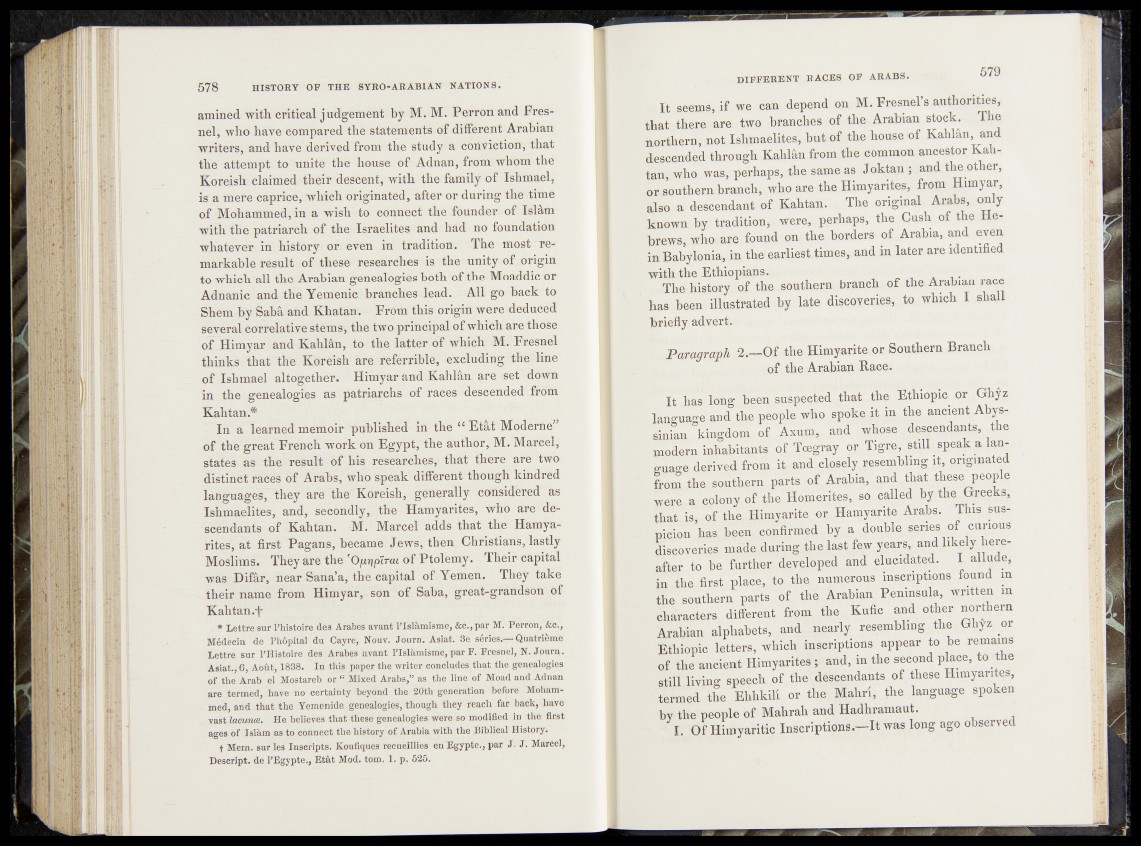
amined with critical judgement by M. M. Perron and Fresnel,
who have compared the statements of different Arabian
writers, and have derived from the study a conviction, that
the attempt to unite the house of Adnan, from whom,the
Koreish'.claimed their, descent, with' the family of Ishmael,
is a mere caprice, which originated, after or during the time
of Mohammed, in a wish to connect the founder of Islàm
with the patriarch of the Israelites and had no foundation
whatever in history on even in tradition. The most- remarkable
result of these researches is the unity of „origin
to which all the Arabian genealogies both of the Moaddic or
Adnanic and the Yemenic branches lead. All go back .to
Shem by Saba and Khatan. From this origin were.deduced
several correlative stems, the two principal of which are those
of Himyar and Kahlân, to the latter of which M. Fresnel
thinks that the Koreish are referrible, excluding the line
of Ishmael altogether. Himyar and Kahlân; afë'set down
in the genealogies as patriarchs of races descended'from
Kahtan.* I
In a learned memoir published in the cc Etat Modëdè*^
of the great French work on Egypt, the author, M. Marcel,4
states as the result-of his researches, that there arie’ two
distinct races of Arabs, who speak different though kindred
languages, they are the Koreish, generally considered as
Ishmaelites, and, secondly, the Hamyarites, who are descendants
of Kahtan. M. Marcel adds that the Hamyarites,
at first Pagans, became Jews, then Christians, lastly
Moslims. They are the 'Ogripircu of Ptolemy. Their- capital
was Difâr, near Sana’a, the capital of Yemen. They take
their name from Himyar, son of Saba, great-grandson 1 of
Kahtan.*f*
* Lettre sur l’histoire des Arabes avant l’Islàmisme, &c.,par M. Pérron, &c.,
Médecin de l’hôpital du Cayre, Nouv. Journ. Asiat. 3e séries.— Quatrième
Lettre sur l’Histoire des Arabes avant l’Islàmisme, par F. Fresnel, N. Journ.
Asiat., 6, Août, 1838. In this paper the writer concludes that the genealogies
of the Arab el Mostareb or “ Mixed Arabs,” as the line of Moad and Adnan
are termed, have no certainty beyond the 20th generation before Mohammed,
and th a t the Yemenide genealogies, though they reach far back, have
vast larnnoe. He believes th a t these genealogies were so modified in the first
ages of Islàm as to connect the history of Arabia with the Biblical History.
t Mem. sur les Inscripts. Koufiques recueillies en Egypte., par J. J. Marcel,
Descript, de l’Egypte., E tâ t Mod. tom. 1. p. 525.
DIFFERENT RACES OF ARABS. 6 7 9
It seems, if we can depend on M. Fresnel’s authorities,
that H H O B two branches . of the Arabian stock. The
northern, not Jshmaelit^bufcof the Muse of Kahlän, and
descendfi through Kahl|n from the common ancestor Kahtan,
who was, perhaps^rthe same as Joktan ; and the other,
orssouthermbrafieh,#who;ai!.eith.e Himyarites, from Himyar,
also a descendant of Kahtan.^ The original Arabs, only
known tradition,' were, perhaps-,; the Cush of the Hebrews*
who are found omthe^borders of Arabia, and even
in Babylonia,, in the earliest .times.,, and Änjater. are identified
with .the Ethiopians-’’ • ' ‘
The history, of the squtfeu, branch of the Arabian race
has been: illustrated by. late discqyeri$$;.]to which I shall
briefly advert.
Paragraphj 2.-r-0.f the Himyaritesor Southern Branch
of* ther Arabian Racei
I It haw long been | § ^tblopic or Ghyz
languag^and the H H ^ho sppke^t m the^a|jm^t Abyssinian
kingdom ofl’Axum, a p p who^desceiid^n|s, the
modern inhabitants of Toegray or.Tigr.e^ stillï.speak a language
d e rS f r o m S a n d
from theVsoutbem parts- Ó* Arabia, ^ t h a t these people
were a-colony of the the Creeks,
that isTof the, Himyarite or Hamyanie Arabs. This suspicion
has been confirmed tj,a J o u > le series ^ - carious
discoveries M W » ™ andjikely hereafter
to be further, developed and elucidated. I allude,
in the first place,* to, the numerous inscriptions found m
the southern parts of thé Arabian Peninsula, written in
characters different from B Kuflc.and other northern
Arabian alphabets», and nearly, resembling the Ghyz or
Ethiopië letters, which inscriptions appear to be remams
of the aneient Himyarites; - and» in the second place, to the
still living speech of the descendants of these Himyarites,
termed the Ehhkill or the Mahri, the language spoken
by the people of Mahrah * and Hadhramaut. * ^ • 1- T ± <irn a orrn nhsP/TVfid.